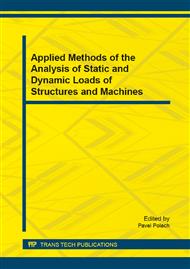[1]
G. Lepoittevin, G. Kress, Finite element model updating of vibrating structures under free-free boundary conditions for modal damping prediction, Mechanical Systems and Signal Processing, 25 (2011) 2203-2218.
DOI: 10.1016/j.ymssp.2011.01.019
Google Scholar
[2]
H. Koruk, K. Y. Sanliturk, On measuring dynamic properties of damping materials using Oberst beam method, in: Proceedings of the ASME 2010 – ESDA2010, Istanbul, (2010).
DOI: 10.1115/esda2010-24452
Google Scholar
[3]
Z. Xie, W.S. Shepard Jr., Development of a single-layer finite element and a simplified finite element modeling approach for constrained layer damped structures, Finite Elements in Analysis and Design 45 (2009) 530-537.
DOI: 10.1016/j.finel.2009.03.001
Google Scholar
[4]
S. Z. Rad, Methods for updating numerical models in structural dynamics, Thesis, Imperial College of Science, Technology and Medicine, University of London, London, (1997).
Google Scholar
[5]
V. Arora, S.P. Singh, T.K. Kundra, Finite element model updating with damping identification, Journal of Sound and Vibration 324 (2009) 1111-1123.
DOI: 10.1016/j.jsv.2009.02.048
Google Scholar
[6]
V. Zeman, Z. Hlaváč, Vibration of mechanical systems, FAS UWB in Pilsen, Plzeň, 2004. (in Czech).
Google Scholar
[7]
D.J. Ewins, Modal Testing: Theory and Practise, Bruel & Kjaer, (1985).
Google Scholar
[8]
L. Ye, Comparison of Finite Element Method Modal Analysis of Violin Top Plate, Music Technology Area, Department of Music Research, Schulich School of Music, McGill University, Montreal, (2013).
Google Scholar
[9]
W. van Hal, NVH Damping Approaches, Automotive CAE Grand Challenge, (2014).
Google Scholar
[10]
VP Solution 2013 – Solver Reference Manual ESI-GROUP. (2013).
Google Scholar


